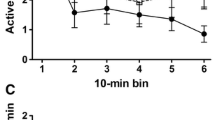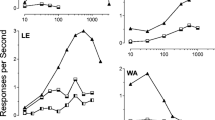Abstract
Key pecking by pigeons was maintained under either a 5-min fixed-interval or a 30-response fixed-ratio schedule of food delivery. d-Amphetamine (0.1–1.0 mg/kg) either increased or did not affect overall rates of responding under the fixed-interval schedule; the lowest dose of ethanol (0.5 g/kg) did not affect or slightly decreased response rates, whereas higher doses (1.0–2.0 g/kg) substantially decreased rates. Combinations of low noneffective ethanol doses with most doses of d-amphetamine increased rates of responding under the fixed-interval schedule above those obtained with d-amphetamine alone; decreases produced by the higher doses of ethanol were attenuated by most doses of d-amphetamine. Doses of d-amphetamine (0.1–1.0 mg/kg) and ethanol (0.5–1.5 g/kg) alone generally had no effect on responding maintained under the fixed-ratio schedule; higher doses of these drugs decreased responding. The effects of dose combinations other than the highest ones generally differed little from those obtained with ethanol alone; the effects of high doses of each drug were antagonized by low to moderate doses of the other. Combinations of ethanol with d-amphetamine can result in higher rates of responding than are obtained with either drug alone. Further, effects of the drugs alone and in combination depend on the schedule under which behavior is maintained.
Similar content being viewed by others
References
Barrett, J. E., Witkin, J. M.: Interaction of d-amphetamine with pentobarbital and chlordiazepoxide: Effects on punished and unpunished behavior of pigeons. Pharmacol. Biochem. Behav. 5, 285–292 (1976)
Branch, M. N.: Behavior as a stimulus: Joint effects of d-amphetamine and pentobarbital. J. Pharmacol. Exp. Ther. 189, 33–41 (1974)
Dews, P. B.: Studies on behavior: IV. Stimulant actions of methamphetamine. J. Pharmacol. Exp. Ther. 122, 137–147 (1958)
Dews, P. B., DeWeese, J.: Schedules of reinforcement. In: Handbook of psychopharmacology, Vol. 7, L. L. Iversen, S. D. Iversen, and S. H. Snyder, eds., pp. 107–150. New York: Plenum 1977
Ferster, C. B., Skinner, B. F.: Schedules of reinforcement. New York: Appleton-Century-Crofts 1957
Katz, J. L., Barrett, J. E.: Effects of ethanol on behavior under fixedratio, fixed-interval, and multiple fixed-ratio fixed-interval schedules in the pigeon. Arch. Int. Pharmacodyn. Ther. 234, 88–96 (1978)
Kelleher, R. T., Morse, W. H.: Determinants of the specificity of the behavioral effects of drugs. Ergeb. Physiol. 60, 1–56 (1968)
Kissin, B.: Interactions of ethyl alcohol and other drugs. In: The biology of alcoholism, Vol. 3, B. Kissin and H. Begleiter, eds., pp. 109–161. New York: Plenum 1974
Leander, J. D., McMillan, D. E., Ellis, F. W.: Ethanol and isopropanol effects on schedule-controlled responding. Psychopharmacology 47, 157–164 (1976)
McMillan, D. E.: The effects of sympathomimetic amines on schedule-controlled behavior in the pigeon. J. Pharmacol. Exp. Ther. 160, 315–325 (1968)
McMillan, D. E., Leander, J. D.: Effects of drugs on schedulecontrolled behavior. In: Behavioral pharmacology, S. D. Glick and J. Goldfarb, eds., pp. 85–139. St. Louis: Mosby 1976
Rech, R. H., Vomachka, M. K., Rickert, D. E.: Interactions between depressants (alcohol-type) and stimulants (amphetamine-type). Pharmacol. Biochem. Behav. 8, 143–151 (1978)
Rushton, R., Steinberg, H.: Dose-response relations of amphetamine-barbiturate mixtures. Nature 197, 1017–1018 (1963)
Rushton, R., Steinberg, H., Tomkiewicz, M.: Effects of chlordiazepoxide alone and in combination with amphetamine on animal and human behavior. In: The benzodiazepines, S. Garattini, E. Sussini and L. O. Randall, eds., pp. 355–366. New York: Raven 1973
Rutledge, C. O., Kelleher, R. T.: Interactions between the effects of methamphetamine and pentobarbital on operant behavior in the pigeon. Psychopharmacologia 7, 400–408 (1965)
Sansone, M.: Effects of chlordiazepoxide, CNS stimulants and their combinations on avoidance behavior in mice. Arch. Int. Pharmacodyn. Ther. 215, 190–196 (1975)
Smith, C. B.: Effects of d-amphetamine upon operant behavior of pigeons: enhancement by reserpine. J. Pharmacol. Exp. Ther. 146, 167–174 (1964)
Smith, J. B.: Effects of d-amphetamine and pentobarbital in combination with single or repeated daily injections of morphine in the pigeon. J. Pharmacol. Exp. Ther. 206, 353–360 (1978)
Wallgren, H., Barry, H.: Actions of alcohol, vol. II. Amsterdam: Elsevier 1970
Weiss, B., Laties, V. G.: Effects of amphetamine, chlorpromazine, pentobarbital, and ethanol on operant response duration. J. Pharmacol. Exp. Ther. 144, 17–23 (1964)
Author information
Authors and Affiliations
Rights and permissions
About this article
Cite this article
Katz, J.L., Barrett, J.E. Effects of d-amphetamine and ethanol alone and in combination on schedule-controlled responding of pigeons. Psychopharmacology 64, 13–18 (1979). https://doi.org/10.1007/BF00427338
Received:
Accepted:
Issue Date:
DOI: https://doi.org/10.1007/BF00427338




